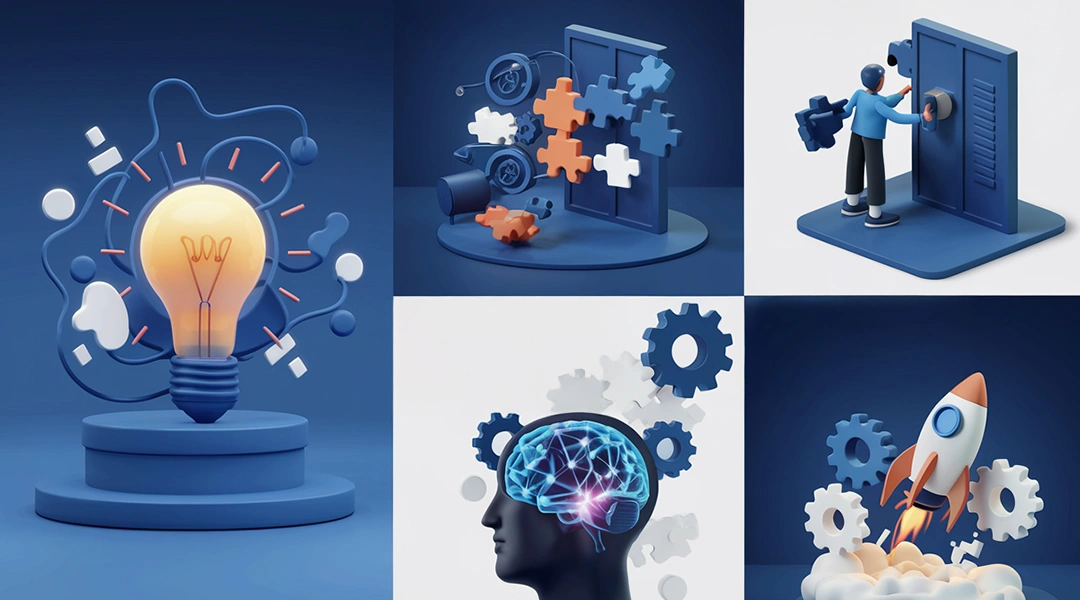- Asaad Abdullah Al-Abbad
- 20/12/1424
- 11/02/2004
Series: Management Development Series
Book: Creativity at Work: A Practical Guide to Creative Thinking
Author: Dr. Carol Goman
Number of Pages: 158
Publisher: Dar Al-Ma’rifa for Human Development
Book idea
Creativity is a skill that works wonders. It is not a mysterious power or a supernatural talent that is monopolized by the lucky ones. Rather, creativity is an energy that every person possesses to varying degrees, and anyone can acquire this skill and become creative. This book gives you effective methods for exploring your own energies and the energies of others, and provides you with the excitement, enthusiasm, and self-confidence to become creative.
Chapter One
Starting Point
What is creative energy?
Creativity is the invention of a new idea.
Innovation is the practical application of creative ideas.
Creative thinking is an innate talent that people are born with, along with a set of acquired skills.
This talent is used to solve everyday problems.
Creative people are those who do not hinder their intellectual creative energy and direct their abilities
in various aspects of life.
Everyone can be creative.
The belief that creativity is limited to a select few is completely false. Everyone has the
ability to be creative, as long as they are provided with the appropriate environment for creativity.
Your IQ is not your creativity. Another misconception about the concept of creativity is that it is limited to the intelligent. However, reality shows that many creative people have average IQs, and some even fail in their formal education.
You were born creative.
Chapter Two
Obstacles to creativity and ways to address them
Every person is born creative, and their creativity peaks at 90% at the age of five. This percentage decreases as a person ages, reaching just under 50% after the age of fifty.
Obstacles to Creativity and How to Overcome Them:
1. Negative Attitudes: These are addressed by controlling your attitude and focusing on the potential opportunities within the problem. Every problem has both an apparent negative and a hidden positive side. Unfortunately, we always focus on the apparent negative aspects and overlook the positive aspects.
2. Fear of Failure: Some people place the possibility of failure in any task they undertake, thus setting themselves up for failure before they even begin. They fear failure throughout their entire performance, which will undoubtedly lead to failure, because what you think about happens to you.
3. Excessive Stress: This undoubtedly has a significant impact on the psychological state, generating pressure. This weakens emotions and, with it, weakens thinking, thus lowering the level of creativity. Creativity can only function in an atmosphere of calm, reassurance, stability, and deep relaxation that prepares your body and mind for creativity.
4. Following rigid rules:
Following rules and instructions literally creates a one-size-fits-all pattern of understanding, which hinders creativity and makes people feel that these rules are only applicable in this way. This closes off the door to creativity. Therefore, break these outdated rules and instructions, especially those related to everyday routines, and work to explore an innovative and creative way to achieve what you want in the shortest possible way.
5. Forming hypotheses:
Putting general hypotheses on things can make them seem like givens. The biggest problem is that these hypotheses are false and not based on evidence. This hinders creativity and renders thinking rigid. Therefore, carefully examine information before making judgments.
6. Over-reliance on logic:
Constantly relying on logic is one of the obstacles to creativity, while creative thinkers often develop logical approaches to problem-solving.
7. Believing You Are Not Creative
Research has shown that the human brain’s creative potential is limitless. The only limitation stems from within us, through our belief that we are not creative. The problem is when we accept this without any thought or discussion. Therefore, we must believe that we are creative, starting from within ourselves by changing the false belief that keeps us from being creative.
Chapter Three
Idea generation methods
Letting Go of Preconceptions
We have a wealth of information in our minds about past failures and our own experiences in which we didn’t succeed. Our constant belief in our own failures prevents us from trying many methods. Dwelling on failed experiences gives us the initial impetus for failure.
Generating Ideas in One Minute
Focus on the quantity of ideas, not the quality.
Write down each idea. Don’t judge or criticize the ideas.
Be relaxed, cheerful, and friendly.
Change Your Perspective.
Ask yourself questions like, “What would happen if…?”
Different Perspectives
The creative thinking process begins with the convergence of ideas stemming from diverse perspectives. Combining these perspectives is the beginning of creative thinking.
The Hemispheric Theory
The right side of the brain controls the left side of the body, and the left side of the brain controls the right side of the body. This division applies to people who use their right hand to write. However, in the case of left-handed people, the brain functions are reversed. This table shows the functions of the right and left brains for right-handed people.
|
Intuition
|
|
Visual thinking
|
|
Creative thinking
|
|
Holistic thinking
|
|
Artistic thinking
|
|
Joy
|
|
Fun
|
|
It does not receive much attention in our education system.
|
Walking and breathing have been found to activate the non-dominant hemisphere of the brain, making both hemispheres more energetic and, consequently, more creative.
Solving the Whole Brain Problem
Reconciling and intertwining the functions of the two hemispheres of the brain (right and left) yields highly effective creative results.
Intuition
Whatever its name, it remains the inner voice that generates feelings for or against our decisions in general, especially when data conflicts or is insufficient. We rely on our sixth sense, intuition, to reach a conclusion.
Techniques for Increasing Practical Intuition
1. Practice predicting the future.
2. Visualize yourself performing a task before it actually occurs.
3. Notice your feelings and sensations that you usually ignore.
4. Keep a record of your thoughts.
5. Learn meditation or self-hypnosis.
6. Symbolic visualization.
Stages of Creativity
Stage One: Preparation
This stage identifies the basic tasks and is based on studying information and research related to a given topic.
Stage Two: Engaging with the Problem
This is the stage of examining the problem from all angles, interests, facts, and dimensions. This means experiencing the problem in all its details and context.
Stage Three: Embracing the Problem
In this stage, let your subconscious mind embrace the problem after it has been absorbed by your conscious mind. Let your subconscious mind, which contains the process of creativity, innovation, and synthesis, search for a solution to the problem.
Stage Four: Reaching the Solution
The preparation and embracing stages combine to produce a solution that suddenly pops into your conscious mind. You say, “I found it!”
Stage Five: Evaluation
This is the stage of selecting and scrutinizing ideas, applying criteria to them, and then judging their suitability or otherwise.
Stage Six: Application
This is the stage of translating creativity into practical reality, meaning that your creative ideas become tangible, useful, valuable, and practical.
Metaphorical Thinking
Many creative people seek to use metaphors in their daily speech and thought patterns… The presence of these expressive methods increases our ability to come up with creative solutions.
Using Similes
Similes move metaphorical thinking to the stage of comparing things and events, finding similarities and differences between them.
Visual Thinking
There is no doubt that visual observations, drawings, and visual aids in general enhance the creative process and thus seek to embrace the mind and ideas and devise solutions. For every idea in our minds, there is a visual representation called a “mind map.” This map provides us with the initial outlines for implementing this idea on the ground. It is important that this map is based on real foundations based on verified data and information.
|
Logic
|
|
Speech
|
|
Analytical
|
|
linear
|
|
Specific thinking
|
|
It is of great interest to us in the education system.
|
Chapter Four
collective creativity
Administrative Matters in the Field of Creativity
The success of a creative team depends on the quality of the individuals involved, in addition to the quality of the supervisor. One of the most important roles in the creative process is to provide a conducive environment for creativity by meeting the creative needs of employees while maintaining the company’s goals.
Eight Ways to Increase Your Employees’ Creativity
1. Involve everyone in building creative collaboration.
2. Encourage employees to write words to add to the team’s vocabulary to transform the team into a more innovative group.
3. Ask your employees to create a celebration that helps reinforce the importance of creativity.
4. Ask your employees to write a creative vision statement.
5. Ask your employees to evaluate each other.
6. Encourage competition in coming up with ideas, even if they come from diverse sources.
7. Use theatrical props to help your employees generate ideas and stimulate creativity.
8. Set a suitable time to return to normal work.
Measuring Positives, Potential, and Objections
Some managers respond to ideas presented to them by their employees with violence, criticism, and perhaps marginalization and ridicule. This frustrates the employee. Yes, I agree with you, manager. Most ideas may be illogical, but you must reject them positively by:
1. Positives: Identify the positives contained in the idea.
2. Potential: Do we have the capabilities, or can we provide the necessary capabilities, to implement this idea?
3. Objections: Present the objections that would make you reject the idea by involving the idea owner in overcoming these objections.
Therefore, it is a mistake to judge the ideas and innovations of others too harshly. All the inventions around us began with ideas, perhaps naive ones!
Intensive Ideas (Brainstorming)
The best method for group creativity is intensive ideation, also known as brainstorming. This brainstorming has its own rules:
The optimal starting group size is between 5 and 12 participants. All participants must be fully familiar with the procedures to be followed. All group members contribute to brainstorming ideas on a given topic. A facilitator or leader manages the brainstorming session, which takes the following forms:
– Idea generation.
– Break.
– Idea evaluation.
– Follow-up.
Idea writing method
This method of brainstorming is for those who do not wish to present their ideas verbally. Therefore, it is used as an alternative to brainstorming. In this method, ideas are written on paper and then the same brainstorming steps are followed.
Functional Connection
When participants run out of ideas when presenting an idea, the facilitator directs participants to identify two unrelated objects and their primary function. They then attempt to connect one of the objects with a link. This is how the wristwatch and car radio were created.
Chapter Five
Innovation and practical solutions
Creativity Policy
You may come up with an idea in your work environment, and you’re convinced of it. However, you face a hurdle: how to get others to support and fund it, and then see it through.
This requires a specific strategy for gathering information and convincing others.
Therefore, one of the most important steps to transforming your creative ideas into an innovative reality is to secure the support of all important people and decision-makers.
Supporting Your Idea Presentation
When presenting your ideas to others, support them by citing examples and models from other companies, publications, and previous consultations. This will give your idea strength and ultimately garner support and commitment.
Key Considerations for Promoting Your Ideas
The success of your idea depends on the strategy you use to promote it, especially in terms of addressing the desires and needs of others.
Personal Evaluation and Action Plan
The problem is that even the best ideas go nowhere because they are never implemented. You now possess extraordinary abilities to embrace creative initiatives in your work environment, provided you develop strategic plans for them to bring your ideas to fruition.



